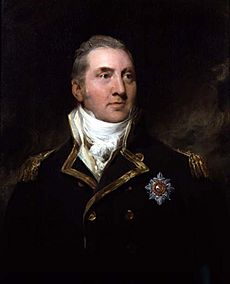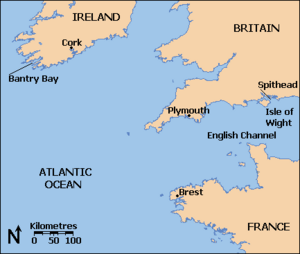Action of 21 October 1794 facts for kids
Quick facts for kids Action of 21 October 1794 |
|||||||
|---|---|---|---|---|---|---|---|
| Part of the French Revolutionary Wars | |||||||
|
Map of the region, the approximate location of the action marked in red |
|||||||
|
|||||||
| Belligerents | |||||||
| Commanders and leaders | |||||||
| Strength | |||||||
| 4 frigates | 1 frigate | ||||||
| Casualties and losses | |||||||
| 3 killed 5 wounded |
8 killed 5 wounded 1 frigate captured |
||||||
The Action of 21 October 1794 was a small but important sea battle. It happened between Great Britain and France during the French Revolutionary Wars. This fight took place off the coast of Brittany, France.
French warships, called frigates, had been attacking British trading ships. They were very successful at this. To stop them, the British Navy sent a group of frigates. Their job was to patrol the French coast. On October 13, 1794, a large French frigate named Révolutionnaire left port. It was commanded by Captain Antoine René Thévenard. The ship was heading out to attack British trade routes.
Eight days later, near Ushant, Révolutionnaire met the British frigate squadron. This squadron was led by Commodore Sir Edward Pellew. His ships had already won many battles against French raiders. Pellew ordered his ships to chase the French frigate. Captain Thévenard tried to escape towards the French coast.
One British ship, HMS Artois, was faster than the others. It was commanded by Captain Edmund Nagle. Artois managed to cut off Révolutionnaire from the shore. The two ships then began to fight. After 45 minutes, the crew of Révolutionnaire gave up. They surrendered their ship even though their captain wanted to keep fighting. Few people were hurt on either side. The British quickly added Révolutionnaire to their own navy. It even helped capture another French ship later on.
Why This Battle Happened

In February 1793, France declared war on Great Britain. The French Navy immediately sent out ships to attack British trade. These ships were called cruisers or privateers. Even though the French Navy had some problems, their ships caused a lot of damage.
To protect their trade, the British Navy formed a special group of frigates. This group was called the "flying squadron." Their mission was to find and stop the French raiders. This squadron had already won several important battles.
By the autumn of 1794, Commodore Sir Edward Pellew was in charge of the squadron. His ship was HMS Arethusa. Other ships in his group included:
- HMS Artois led by Captain Edmund Nagle
- HMS Diamond led by Captain Sir Sidney Smith
- HMS Galatea led by Captain Richard Goodwin Keats
These four ships had the best crews and equipment. They were the best light warships in the British Channel Fleet. On October 19, Pellew's squadron left port. They planned to patrol near Brest to stop ships going in or out.
Meanwhile, the French continued to send out raiding ships. One of these was the new 40-gun frigate Révolutionnaire. It was commanded by Captain Antoine René Thévenard. The ship had left Le Havre on October 13. It was sailing west towards the Atlantic Ocean.
The Sea Battle
On October 21, eight days after leaving Le Havre, Révolutionnaire was spotted. Pellew's squadron saw the French ship at dawn. They were about 25 to 30 miles off the island of Ushant.
Pellew immediately ordered his ships to chase Révolutionnaire. Captain Thévenard tried to escape towards the shore. But the British squadron was in a better position. They were "to windward," meaning the wind was helping them. This blocked Révolutionnaire from reaching the safety of the coast. Instead, the French ship turned southeast, trying to outrun the British.
The Fight Begins
Captain Nagle's Artois was the fastest British frigate. Artois was a strong, modern ship. Nagle was able to bring his ship right next to the slightly larger French vessel. For about forty minutes, the two frigates exchanged cannon fire. This is called firing "broadsides."
Artois's shots damaged the French ship's rigging. This made Révolutionnaire slow down. Soon, the rest of Pellew's squadron began to catch up. Captain Smith's Diamond was the first to arrive. Smith positioned his ship behind Révolutionnaire. He fired two warning shots. This meant that if the French ship didn't surrender, he would fire a powerful "raking broadside." This type of shot would hit the French ship from end to end, causing huge damage.
Arethusa and Galatea were close behind Diamond. Captain Thévenard wanted to keep fighting. But his crew refused to continue. The French captain had no choice but to surrender his ship. At that moment, the dangerous Saints Rocks were visible directly ahead.
After the Battle
Not many people were hurt in the battle. Révolutionnaire lost five men killed and four wounded. Captain Thévenard himself had minor injuries. Artois was the only British ship that fought closely. It lost two sailors and one officer killed, and five men wounded.
Pellew's squadron took Révolutionnaire to Falmouth. They found that some French prisoners had small pox. The French ship had only light damage. This meant the British Navy could quickly buy and use it. It became the 38-gun HMS Révolutionnaire. Captain Francis Cole took command. The ship then joined Pellew's squadron.
About 18 months later, HMS Révolutionnaire captured another French frigate, Unité. Révolutionnaire served in the Royal Navy for 21 more years. When Révolutionnaire arrived in Britain, it impressed naval architects. It was much larger than British-built frigates at the time. The British even designed a new ship based on Révolutionnaire. However, this new ship, HMS Forte, wasn't launched until 1814.
Captain Nagle was honored for his bravery. He was made a Knight Bachelor. First Lieutenant Robert Dudley Oliver was promoted to commander. The prize money from capturing the ship was also very large. Part of it, £10,000, was paid in January 1795. This money was shared among the entire squadron.
Pellew had been knighted the year before. He was reportedly unhappy that Nagle was honored for this action. Pellew complained about the condition and speed of his own ship, Arethusa. He asked for a faster vessel. The next year, he received command of the powerful HMS Indefatigable.


